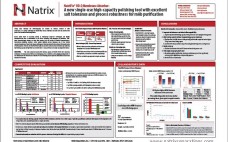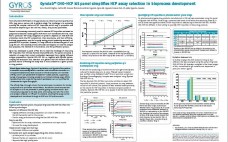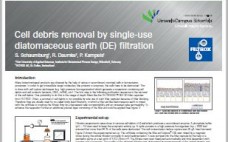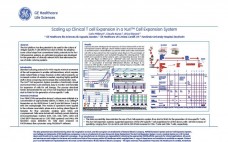Purity, recovery, and elution volume are important factors and parameters when screening multiple media (resins) for the development of efficient, robust, and economical production processes. Among a selection of mixed-mode media evaluated for the purification of MAb S, CHT™ Ceramic Hydroxyapatite provided the best monomer recovery at 83% in the smallest elution volume with a target purity of 99.5%. Using a bind and elute strategy provided enhanced purification power compared to flow-through modes.
Poster Hall
Rapid High Performance Quantification of Human IgG Using an Automated Gyrolab System
The development and manufacture of biotherapeutics requires efficient and timely analytical support to monitor both quantity and quality in products and processes. Productivity is important already during early development. Further downstream, selected cell lines must be optimized for productivity, followed by bioprocess development to yield g/L concentrations of IgG product. The immunoassays that are often used to determine IgG titer must have the flexibility to measure the broad range of concentrations encountered during cell-line and process development, and Gyrolab huIgG…
NatriFlo® HD-Q Membrane Adsorber: A New Single-Use High-Capacity Polishing Tool with Excellent Salt Tolerance and Process Robustness for MAb Purification
Strong anion exchange (Q) chromatography has become an industry standard in MAb production. It is a proven technology to remove DNA, viruses, endotoxins and acidic host cell proteins from process feed streams in flowthrough mode. Recent trends show an increasing interest in downstream single-use technologies and flexible biomanufacturing due to advancement in cell culture technology and emergence of biosimilars. Traditional chromatography columns are slow, often oversized and not suitable for flexible biomanufacturing. Conventional membrane adsorbers cannot provide sufficient process robustness…
Gyrolab™ CHO-HCP Kit Panel Simplifies HCP Assay Selection in Bioprocess Development
Host cell protein (HCP) levels in drug products are critical to product quality since HCPs may pose a serious risk to patient safety. The challenge is to accurately quantify the complex mixture of HCP impurities, which vary in properties and abundance depending on the cell line, media, and process parameters. Generic immunoassays commonly used to measure HCP impurities are based on polyclonal antibodies raised against HCPs from non-transfected cell lines. How well a particular HCP assay recognizes all proteins depends…
Enhanced Endotoxin Removal By Synergistic Effect of Positively Charged Depth Filtration and Polyethylene Glycol
Recombinant therapeutic proteins derived from E. coli require robust endotoxin removal, ideally performed using multiple process steps providing orthogonal and robust clearance. Typical recovery processes for E. coli expressed proteins consist of cell harvest by centrifugation, homogenization, collection of inclusion bodies by centrifugation, solubilization, refold, and clarification by depth filtration. Endotoxin clearance across the recovery operations is usually on the order of one log. Here, we demonstrate that endotoxin clearance can be enhanced to five logs by using 16% polyethylene…
Cell Debris Removal By Single-Use Diatomaceous Earth (DE) Filtration
Many biotechnological products are obtained by the help of native or recombinant microbial cells in fermentation processes. In order to get intracellular target molecules, like proteins or enzymes, the cells have to be destructed. This is done with cell rupture techniques (e.g. high-pressure homogenization) which generate a suspension containing cell debris and cell contents (proteins, DNA, mRNA, etc.). The first step in the following purification sequence is the removal of the cell debris. One possibility to do this is the…
Development and Optimization of CHOgro® Transient Expression Technologies for High Titer Antibody Production in Suspension CHO Cells
During early stage drug development, quickly obtaining relevant candidate proteins through transient transfection can accelerate drug dis-covery. High titers are often obtained from Human Embryonic Kidney (HEK) 293 derived cell types; however, the use of different host cells between early stage transient and later stable protein production is a concern and can lead to the advancement of false-positive candidates. Chinese hamster ovary (CHO) cells are a desirable target cell type due to growth characteristics and a history of regulatory approval;…
Development of a Novel Cold Chain Tubing, FP-FLEX™, and Single- Use Freezing Bag for Working Cell Banks Enabling Closed-System Processing to Temperatures as Low as -196°C
Working cell banks (WCB’s) are commonly applied to initiate cell culture manufacturing campaigns for production of therapeutic proteins. These campaigns typically begin with inoculation of cells previously cryopreserved in vials. While vials are typically used to establish WCB’s and initiate manufacturing campaigns, they are not optimal for the growing demands of commercial production. Vials are small and filling/removal is performed through an open cap. This process leads to numerous manual operations and culture vessels, resulting in contamination risks and potential…
Scaling Up Clinical T cell Expansion in a Xuri™ Cell Expansion System
Administration of antigen-specific T cells (ASTs), in particular for viral infections in transplantation, is one of the key focuses in immunotherapy. The Xuri™ Cell Expansion System can be used as an alternative to static cell culture methods for the stimulation and expansion of ASTs. The process described here demonstrates the use of the Xuri Cell Expansion System from the initiation of culture to the generation of virus-specific T cells. This includes a semi-static phase for antigen stimulation, a rocking phase…
Design of a New Range of High Capacity and High Flow Agarose Resins
With the continuing development of high titer cell lines, resins with very high capacity at relevant residence times are becoming increasingly important. This paper will present application and characterization data from a set of novel, agarose-based resins, with ion exchange functionality as well as with immobilized alkaline stable Protein A. The cation exchanger has a dynamic binding capacity of more than 120 mg monoclonal antibody/mL resin without the introduction of surface extenders. Performance data from an alkaline stable Protein A…










